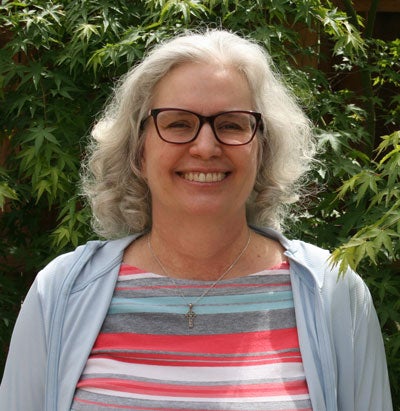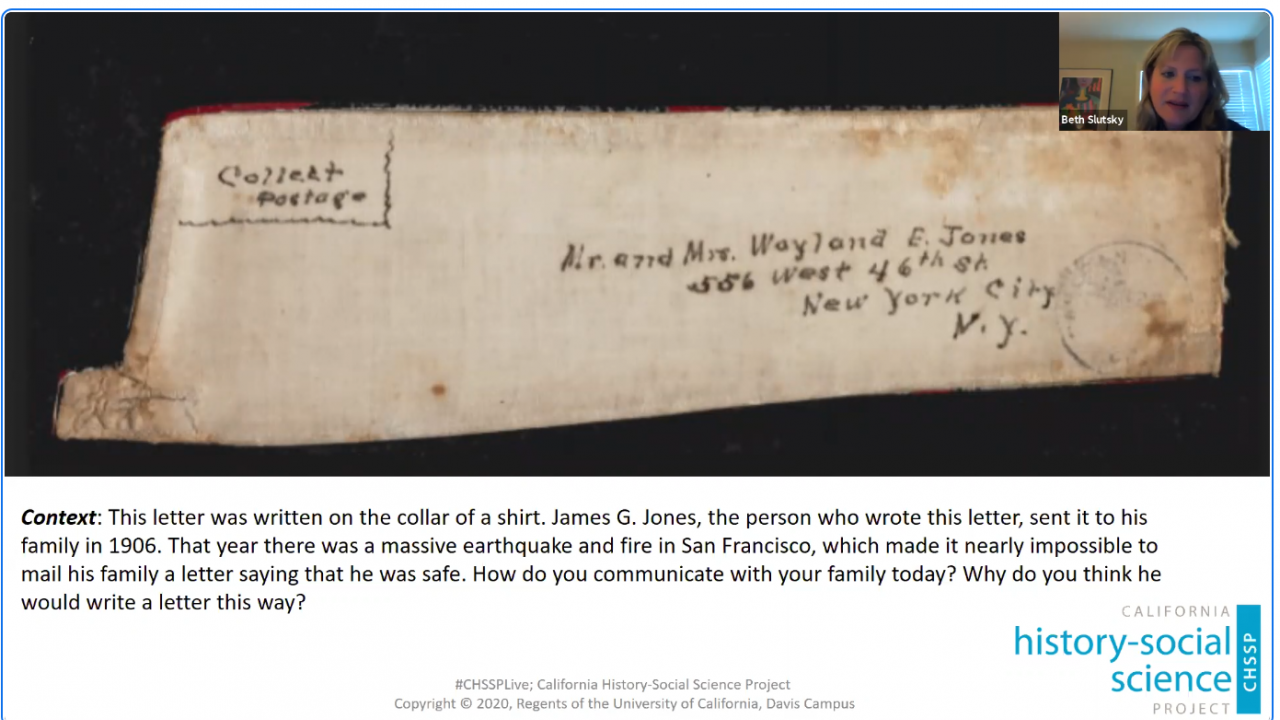Like many people, Nancy McTygue, executive director of the California History-Social Science Project, has been on a lot of Zoom calls in the past several days. As a lifelong educator, her perspective inspired her to develop resources for parents now trying to juggle work and helping their children learn.
On both statewide and national calls during the past two weeks, what struck her most is children coming on camera, or talking, on calls. In one conference call, a woman in another state had children jumping onto her lap, she said.
“I could hear the desperation in her voice,” McTygue said. And she could sense how annoyed everyone else was on the call. Beyond that, McTygue added, she observed the same kinds of frustrations by mothers and fathers of young children who are also her CHSSP site leaders located at five University of California campuses and one California State University campus.

“I knew we had to do something for these parents.” — Nancy McTygue, executive director, California History-Social Science Project
McTygue heads up CHSSP, which is a statewide network and resource for history and social science educators headquartered at the University of California, Davis. That project ordinarily develops teaching materials and resources for teachers throughout the state. So she decided to offer direct help to parents too under the coronavirus shelter-in-place orders. She and her colleagues at UC Davis and at five other university locations have started posting resources for parents — lesson plans, reading lists, blogs of encouragement — as well as for teachers trying to teach remotely for the first time.
At a Glance
California-History Social Science Project
The project, headquartered at UC Davis, provides, among other things, the guidelines for California history and social science teaching.
They are part of the California Subject Matter Projects, administered by the UC Office of President.
Campus sites are located at the UC campuses, including Davis, Berkeley, Irvine, Los Angeles and Santa Cruz, and at California State University, Dominguez Hills.
Helping children continue to learn
Schools, districts, regions and states vary as far as being prepared to teach remotely, she explained. And, parents, even if they are educators like herself, are not often prepared to teach remotely, she said.
“And, teaching your own children, even if you are a teacher, is a whole different thing,” she added. “Our goal, really, is to provide resources for parents and teachers to help children continue to learn.”
Resources on the new part of their site, called CHSSPLive, include:
- A special coronavirus support page with links to lessons, articles, and resources developed at Davis and across the state to help both teachers and parents.
- A special issue of their Current Context (publication) series, entitled Coronavirus, Animals, and Human Health, along with a related Teaching about Pandemics post.
- A new page just launched (and quickly expanding) specifically for parents trying to homeschool their children. It includes lesson plans.
- Blog posts for teachers and parents, including ones written by McTygue in recent days:
- School is in Session – Just at a Distance
- Bay Area Teacher’s COVID-19 Assignment Goes Viral
- Fighting the Coronavirus with Social Media
- Keep Calm and Parent On (which has been viewed by more than 2,000 distinct users since it was posted a week ago).
- A short video, by CHSSP’s Beth Slutsky, who works as an academic coordinator with McTygue at the CHSSP statewide office, for parents. This video explains and illustrates a short history lesson on the 1906 California earthquake parents can teach their children. It teaches parents how to teach and give a lesson.
More resources are coming quickly. They are working on a grade-by-grade, easily understandable description of what your child should be learning in each grade. This week they will also post a reading list for children in kindergarten through fifth grade.
Slutsky, who has three elementary children at home she is trying to teach right now, wanted to come up with a lesson that would be immediately relatable, and the San Francisco earthquake lesson she put on video worked. “For one, Californians are experiencing a crisis, and it’s important for students to make sense of it by learning about how people have responded to crises in the past; there are important points about continuity and change, historical context, and historical empathy that can come from that.”
And, she said, students might be moved to explore other examples in the current pandemic. “This is perhaps what can inspire students to get creative with analyzing sources in their own worlds.”
Additional help comes in the form of a student journal assignment posted by the UC Berkeley CHSSP site. And the History Project site at UCLA is collecting data, or stories from teachers all over the state, documenting their COVID-19 experiences to catalog a history, for the future, on how a pandemic was handled by California teachers.
Calming parents
The lessons and blogs offer a calm voice in a frantic time. In McTygue’s “Keep Calm and Parent On” blog, she urges parents, above all, not to feel guilty.
In the blog, she writes: “… I want to make a radical suggestion. Please take a deep breath and stop beating yourselves up. Recognize that this is an unprecedented and hopefully once-in-a-lifetime event. You’ve probably discovered that even your best-laid homeschool plans fell apart by lunch on the first day, right?”
She continues, “ … given my 30 years in education, and 25 years as a parent, I want you to focus on the big stuff. I recommend just two things that every parent should seriously consider during this crisis: 1) spend time with your kid doing things you both will enjoy, and 2) do something for someone else.”
McTygue said creating the resources makes her feel less helpless, too.
“We are clearly not a first responder, but we are just trying to be helpful in a crisis,” she said. “I just feel so bad for these people with little kids at home.”
Media Resources
Karen Nikos-Rose, News and Media Relations, 530-219-5472, kmnikos@ucdavis.edu
